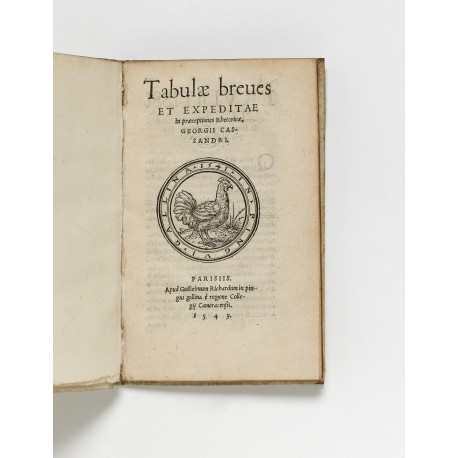 View larger
View larger
Tabulae breves et expeditae in praeceptiones Rhetoricae
- Subjects
- Education - Rhetoric - Early works to 1800
- Authors/Creators
- Cassander, Georgius, 1513-1566
- Printers/Publishers
- Richard, Guillaume, active 1540-1545
- Owners
- Macclesfield, Earls of
One of three known copies
Cassander, Georgius
Pittem (West Flanderss) 1513 – 1566 Cologne
Tabulae breves et expeditae in praeceptiones Rhetoricae.
Paris, Guillaume Richard, 1543
octavo (165 × 105 mm), (20) ff. signed A–B8 C4 and paginated [1]–39 (1). Richard’s woodcut device on the title-page (une Poule grasse, lettered around ‘In Pingvi gallina 1541’; Renouard no. 976); Christian Wechel’s ‘Pegasus’ device on last page (Renouard no. 1117, from a book printed in 1538).
provenance contemporary marginalia, and annotation Emptus 6d on last page — Earls of Macclesfield, embossed stamp on title-page and following two leaves, exlibris North Library dated 1860 on paste-down — Sotheby’s, ‘The Library of the Earls of Macclesfield removed from Sherburn Castle, Part Twelve: Continental books and manuscripts’, London, 2 October 2008, lot 4382
Paper fault in last leaf affecting a few letters, otherwise in excellent state of preservation.
binding contemporary flexible vellum.
The earliest known edition of this popular textbook, dividing rhetoric into three parts: invention, disposition, and elocution (omitting pronunciation and memory), each introduced in a series of questions and answers explicated by examples, followed by some precepts of composition.

The author (Jooris Casant) had matriculated in the Collegium Trilingue in Louvain in 1531 and in 1534 was promoted Master of Arts.1 He taught thereafter in the famous school of Eligius Hoeckaert in Ghent, where his edition of the Sententiae of Plautus (1536) and a short treatise on coinage (1537) were published at the press of Joos Lambrecht. In 1541 Cassander was appointed professor of bonæ litteræ in the school founded by the late Bishop Joannes Albius (de Witte) in Bruges and on 3 May 1541 delivered his inaugural oration in praise of the founder and of the town of Bruges (printed by J. Lambrecht, 1541). In February 1543 Cassander abruptly resigned his post to travel to Italy with his patron, Cornelius Wouters; on his return, he settled in Cologne, and in September 1544 matriculated there as a student of theology.
Cassander’s textbook is dedicated at Bruges in 1542 to the trustees of Albius’ foundation, the physician Cornelius van Baersdorp (1484–1565), and the banker, Jehan Claissone (Claeyssone). Since there is no trace of an edition of that year printed in Flanders, Cassander may have taken the manuscript with him when he left Bruges, and caused it to be printed at Paris. An edition from the press of Guillaume Richard, allegedly dated 1542, is cited by Renouard; however no copy of it is recorded elsewhere.2 Our edition of 1543 was published by Guillaume Richard in partnership with Chrétien Wechel, whose share of the copies has the imprint ‘Ex officina Christiani Wecheli, sub scuto Basiliensi in uico Iacobaeo & sub pegaso in uico Bellouacensi, anno 1543’ on title-page. Just three copies of the edition are known to the writer:3
● Grenoble, Bibliothèque municipale, F 3492 CGA ● New Haven, Yale University, 2001.635 (with Wechel’s address on title-page) ● Paris, Bibliothèque Mazarine, 8° 20461-5 (with Wechel’s address on title-page)
In 1550, an edition ‘Multò quàm antea emendatiores, atque ab ipso autore recognitae’ was first published at Cologne. Apart from an elaboration of the dedication, acknowledging van Baersdorp’s appointment in that year as court-physician to the Emperor Charles v, it is an unchanged reprint.
New editions by Guillaume Richard’s successor (Thomas Richard) appeared in 1549, 1552–1553, 1557, 1558, 1561, and 1564. Further editions were printed at Antwerp in 1544 (Joannes Steelsius) and 1548;4 Caen in 1569 (Pierre Philippe); Cologne in 1550 (Martin Gymnich), 1553 (s.n.), 1554 (Walther Fabritius), and 1573 (Martin Ordenbach); Dortmund in 1550 (Melchior Soter); Lyon in 1573 (Louis Cloquemin & Étienne Michel); Paris in 1545 and 1546 (both by Chrétien Wechel), 1546 (Mathieu David), 1547 (s.n.), 1548 (C. Wechel), 1549 (M. David), 1549 (Robert Estienne), 1550 (Widow of Maurice de La Porte), 1551 (R. Estienne), 1560 (Gabriel Buon), 1565 (G. Buon), 1578 (Martin Le Jeune), and 1582 (Thomas Brumen); Palermo in 1571 (Giovanni Matteo Maida); Poitiers in 1551 (Jacques Bouchet); Valencia in 1553 (Juan Mey);5 Venice in 1553 (Michele Tramezzino); Zerbst in 1583 (Bonaventura Schmidt); and Zwolle in 1545 (Jan van Ruremonde). With few exceptions, each of these editions likewise is known to the writer by a handful of copies.
reference Ferdinand Buisson, Répertoire des ouvrages pédagogiques du xvie siècle: bibliothèques de Paris et des départements (Paris 1886), p.125
1. A.C. de Schrevel, Histoire du Séminaire de Bruges (Bruges 1895), i, pp.263–264, ii, pp.50, 179; Henry de Vocht, History of the Foundation and Rise of the Collegium Trilingue Lovaniense 1517–1550 (Louvain 1954), pp.296–298; J. Machiels, De Boekdrukkunst te Ghent tot 1560 (Ghent 1994), pp.121–124, 129.
2. Philippe Renouard, Les marques typographiques parisiennes des xve et xvie siècles (Paris 1926–1928), p.314.
3. Buisson, op. cit., p.125, locates a copy in the Bibliothèque municipale de Chartres which is not confirmed by modern catalogues. The 1543 edition is overlooked by most later students of Renaissance rhetorical theory, who persistently identify 1548 as the earliest edition; see Lee A. Sonnino, A Handbook to Sixteenth-century Rhetoric (London 1968), p.234; and Lawrence D. Green and James J. Murphy, Renaissance rhetoric short title catalogue, 1460–1700 (Aldershot 2006), p.100.
4. Cited by Sonnino and by Green and Murphy, op.cit., p.234, otherwise unverified.
5. Xavier Gómez Font and Ferran Grau Codina, ‘La edición de Andrés Sempere de las Tabulae breues et expeditae in praeceptiones rhetoricae de Georgius Cassander’ in Nova et vetera: Nuevos horizontes de la Filología latina (Madrid 2002), ii, pp.973–982 (wrongly indicating 1544 as first edition).


